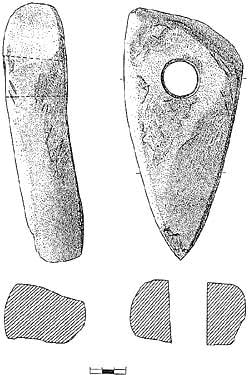Český Krumlov Castle in the 20th Century
During the 13th century the mediaeval castle was built on the promontory above the confluence of the Vltava River and the Polečnice Stream, where the settlement had already appeared in the spell of the Primeval Times. Our first farmers had been attracted by the strategic location near the ford 7,000 years ago. Those ones had not been the last ones.It was clearly confirmed by archaeologists in 1980s. The archaeological research done in the 2nd chateau courtyard contributed to that confirmation at a large extend. The archaeological research was done by the archaeologists working in the museums of Český Krumlov and České Budějovice.
 | |
| Pic. 1 |
The oldest archaeological discovery from the area of the chateau premises dates back to the turn of the 5th and 4th century BC. An axe-hammer made of stone dating from the early Stone Age - Neolithic Period (picture 1) was discovered by chance during the World War II in the 1st chateau courtyard, in the place where the staircase leads into the Latrán area. It is very probable that the finding is connected with the settlement in the Lower Manor Garden premises near the Latrán area, where some remains of Neolithic Period culture settlement (linear pottery) from the course of the 5th millennium BC were discovered.
In 1995 the archaeologists found and searched the remains of primeval settlement right on the top of original rocky promontory in front of the Eggenberg Mint situated in the 2nd chateau courtyard. Several centimetres thick cultural layer contained a large number of pottery vessel fargments (picture 2,3), animal bones and a fragment of clay weight, which was a component of weaving loom (pictures 2-16). The research work proved the settlement in the spell of the two Primeval Periods - at the turn of the early and mid Bronze Age (approximately 1500 BC), and at the end of the late Iron Age - Halstat Period (approximately the 6th century BC). The then ancestors built knoll settlements or smaller fortified settlements 3,500 years ago. Similar localities of the same age are also known in the Český Krumlov area, for example, at the Dívčí Kámen Castle (Girls´ Stone Castle) or Hrádek Velešín - Kamenná věž (Stone Tower) above the Malše River. All of them may have been remains of net points of support on the ways leading from the Podunají area to the Czech basin, along bigger streams.
A very similar situation seems to have come on the rocky promontory in the town of Český Krumlov during the late Iron Age. It is illustrated with not very numerous pottery fragments with graphite and slightly polished surface (pictures 2-1; 3-1). The knoll settlements and fortified settlements were also built in many other strategic localities. Some discoveries from Hill Raziberg near Boletice or the above mentioned promontory of the Dívčí Kámen Castle.
 Pic. 2 |  Pic. 3 |
The promontory on the confluence of the Vltava River and the Polečnice Stream had not been continuously settled during the Primeval Times. Mostly it had been used by people at the end of the late Bronze Age , late Iron Age and during the last years of the Celts rule ( the 4th - 1st century BC ) while building knoll settlements, in many other Czech regions, too. The location could have been settled by a small group of people, used as a watch point or refuge - during the spell of endangerment.
(me)
Further information :
Český
Krumlov Castle - Prehistory
Archaeological
Research in Český Krumlov
Archaeological
Research in the Český Krumlov Region

